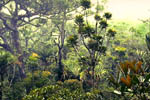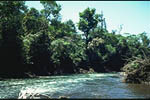 |
QUICK SEARCH
MO PROJECTS:
Africa
Asia/Pacific
Mesoamerica
North America
South America
General Taxonomy
Photo Essays
Training in Latin
America
MO RESEARCH:
Wm. L. Brown Center
Bryology
GIS
Graduate Studies
Research Experiences
for Undergraduates
Imaging Lab
Library
MBG Press
Publications
Climate Change
Catalog Fossil Plants
MO DATABASES:
W³MOST
Image Index
Rare Books
Angiosperm
Phylogeny
Res Botanica
All Databases
INFORMATION:
What's New?
People at MO
Visitor's Guide
Herbarium
Jobs & Fellowships
Symposium
Research Links
Site Map
Search
Diversity, Endemism, and Extinction in the Flora and Vegetation of New CaledoniaConservation
  Protected areas in New Caledonia. From left to right: Pristine forest in the Mt. Panié Special Botanical Reserve; riverine forest in the Rivière Bleue Reserve. New Caledonia's sclerophyllous forests are of unquestionable conservation importance, requiring immediate action. More generally, the entire territory, including each of its native vegetation types, clearly deserves recognition as one of the world's most important biodiversity "hot spots" (Myers, 1988), largely because of the exceptional number of endemic taxa. Although 23 officially recognized terrestrial parks and reserves exist, covering 54,149 hectares (about 2.9% of the land area), the lack of strong protection, and the absence of a clearly articulated environmental policy and consistently enforced regulations are major obstacles to effective long-term conservation (Bouchet et al., 1995). Veillon (1993) points out that several vegetation types are insufficiently represented in the protected areas network, including: 1) sclerophyllous forest, 2) mangrove vegetation, whose floristic composition differs between the east and west coasts, 3) moist evergreen forest primarily on non-ultrabasic substrates in the north and center of Grande Terre, 4) forests in the Loyalty Islands, and 5) maquis on various substrates, mostly in the north and northeast of the island. When New Caledonia is viewed in a global context, and compared with most tropical areas, which are facing far more acute threats from a combination of rapid population growth, extreme poverty, and dysfunctional or non-existent government institutions, the territory’s native flora is relatively well off. New Caledonia’s comparative wealth of the territory (per capita income is similar to that in Australia and New Zealand), coupled with its current political and economic stability, preclude many of the devastating activities that result each year in the degradation and loss of millions of hectares of native vegetation elsewhere in the tropics. New Caledonia nevertheless faces serious threats to its rich biodiversity through habitat destruction and species extinction. The situation is already critical for the tiny fragments of sclerophyllous forest that remain, and could quickly become so for the island's other formations, especially if the political environment deteriorates following the re-consideration of possible independence that is scheduled for 1998. New Caledonia is not a resource-rich territory (despite the presence of huge deposits of nickel ore and other valuable minerals), and its current prosperity is vulnerable. If appropriate action is taken now by responsible leaders in conjunction with scientists and the conservation community, an exceptional opportunity exists to protect an area of remarkable botanical diversity; failure to do so, however, may condemn it to the same irreversible fate that so many other tropical floras have regrettably suffered.
|
© 1995-2025 Missouri Botanical Garden, All Rights Reserved
4344 Shaw Blvd.
St. Louis, MO 63110
(314) 577-5100
Technical Support